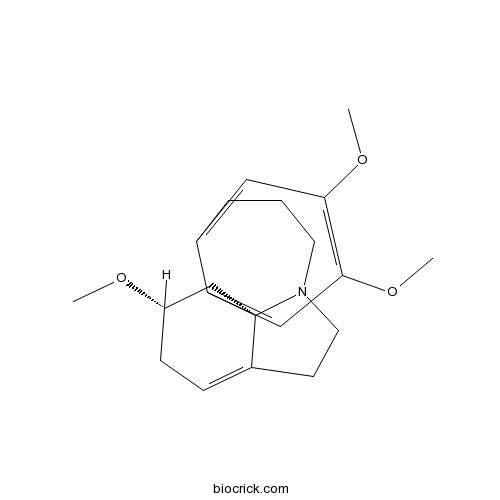2,7-DihydrohomoerysotrineCAS# 51095-85-3 |

Quality Control & MSDS
3D structure
Package In Stock
Number of papers citing our products

| Cas No. | 51095-85-3 | SDF | Download SDF |
| PubChem ID | 296195 | Appearance | Oil |
| Formula | C20H27NO3 | M.Wt | 329.4 |
| Type of Compound | Alkaloids | Storage | Desiccate at -20°C |
| Solubility | Soluble in Chloroform,Dichloromethane,Ethyl Acetate,DMSO,Acetone,etc. | ||
| SMILES | COC1CC=C2CCN3C2(C1)C4=CC(=C(C=C4CCC3)OC)OC | ||
| Standard InChIKey | VFNBFPRWBICVGZ-JXFKEZNVSA-N | ||
| General tips | For obtaining a higher solubility , please warm the tube at 37 ℃ and shake it in the ultrasonic bath for a while.Stock solution can be stored below -20℃ for several months. We recommend that you prepare and use the solution on the same day. However, if the test schedule requires, the stock solutions can be prepared in advance, and the stock solution must be sealed and stored below -20℃. In general, the stock solution can be kept for several months. Before use, we recommend that you leave the vial at room temperature for at least an hour before opening it. |
||
| About Packaging | 1. The packaging of the product may be reversed during transportation, cause the high purity compounds to adhere to the neck or cap of the vial.Take the vail out of its packaging and shake gently until the compounds fall to the bottom of the vial. 2. For liquid products, please centrifuge at 500xg to gather the liquid to the bottom of the vial. 3. Try to avoid loss or contamination during the experiment. |
||
| Shipping Condition | Packaging according to customer requirements(5mg, 10mg, 20mg and more). Ship via FedEx, DHL, UPS, EMS or other couriers with RT, or blue ice upon request. | ||
| Description | 1. 2,7-Dihydrohomoerysotrine possesses cardiodepressant activities on the heart of B. glabrata. |

2,7-Dihydrohomoerysotrine Dilution Calculator

2,7-Dihydrohomoerysotrine Molarity Calculator
| 1 mg | 5 mg | 10 mg | 20 mg | 25 mg | |
| 1 mM | 3.0358 mL | 15.1791 mL | 30.3582 mL | 60.7165 mL | 75.8956 mL |
| 5 mM | 0.6072 mL | 3.0358 mL | 6.0716 mL | 12.1433 mL | 15.1791 mL |
| 10 mM | 0.3036 mL | 1.5179 mL | 3.0358 mL | 6.0716 mL | 7.5896 mL |
| 50 mM | 0.0607 mL | 0.3036 mL | 0.6072 mL | 1.2143 mL | 1.5179 mL |
| 100 mM | 0.0304 mL | 0.1518 mL | 0.3036 mL | 0.6072 mL | 0.759 mL |
| * Note: If you are in the process of experiment, it's necessary to make the dilution ratios of the samples. The dilution data above is only for reference. Normally, it's can get a better solubility within lower of Concentrations. | |||||

Calcutta University

University of Minnesota

University of Maryland School of Medicine

University of Illinois at Chicago

The Ohio State University

University of Zurich

Harvard University

Colorado State University

Auburn University

Yale University

Worcester Polytechnic Institute

Washington State University

Stanford University

University of Leipzig

Universidade da Beira Interior

The Institute of Cancer Research

Heidelberg University

University of Amsterdam

University of Auckland

TsingHua University

The University of Michigan

Miami University

DRURY University

Jilin University

Fudan University

Wuhan University

Sun Yat-sen University

Universite de Paris

Deemed University

Auckland University

The University of Tokyo

Korea University
- Methyl p-hydroxyphenyllactate
Catalog No.:BCN6669
CAS No.:51095-47-7
- Pyrrolidinedithiocarbamate ammonium
Catalog No.:BCC6766
CAS No.:5108-96-3
- Boc-Lys(Z)-pNA
Catalog No.:BCC3419
CAS No.:51078-31-0
- ATC 0175 hydrochloride
Catalog No.:BCC7657
CAS No.:510733-97-8
- ATC 0065
Catalog No.:BCC7666
CAS No.:510732-84-0
- Wogonoside
Catalog No.:BCN1200
CAS No.:51059-44-0
- alpha-Lipomycin
Catalog No.:BCN1842
CAS No.:51053-40-8
- Z-GABA-OH,Z-gama-Abu-OH
Catalog No.:BCC2644
CAS No.:5105-78-2
- Flurbiprofen
Catalog No.:BCC3781
CAS No.:5104-49-4
- Acipimox
Catalog No.:BCC4884
CAS No.:51037-30-0
- Salbutamol Sulfate
Catalog No.:BCC4338
CAS No.:51022-70-9
- (-)-Licarin B
Catalog No.:BCN1241
CAS No.:51020-87-2
- Nicotine 1'-N-oxide
Catalog No.:BCN6892
CAS No.:51095-86-4
- alpha-Onocerol
Catalog No.:BCN5630
CAS No.:511-01-3
- Sugiol
Catalog No.:BCN3164
CAS No.:511-05-7
- Totarol
Catalog No.:BCN4627
CAS No.:511-15-9
- Vitamin D4
Catalog No.:BCC2042
CAS No.:511-28-4
- Plumieride
Catalog No.:BCN5631
CAS No.:511-89-7
- Gitogenin
Catalog No.:BCN3886
CAS No.:511-96-6
- 8-Bromo-cGMP, sodium salt
Catalog No.:BCC6935
CAS No.:51116-01-9
- Cyclic Pifithrin-α hydrobromide
Catalog No.:BCC2407
CAS No.:511296-88-1
- (+)-trans-Isolimonene
Catalog No.:BCC9236
CAS No.:5113-87-1
- (S)-(+)-Ibuprofen
Catalog No.:BCC4042
CAS No.:51146-56-6
- (R)-(-)-Ibuprofen
Catalog No.:BCC4062
CAS No.:51146-57-7
Molluscicidal activities of Dysoxylum lenticellare gillespie constituents on Biomphalaria glabrata say
Phytotherapy Research Volume 2, Issue 2, pages 104–106, June 1988
Four alkaloids, dyshomerythrine (2), 3-epischelhammericine (6), 2,7-Dihydrohomoerysotrine (7); and 3-epi-12-hydroxyschelhammericine (8); two 1-phenylethylisoquinoline, homolaudanosine (9) and dysoxyline (10); a novel alkaloid, dysazecine (3); two diterpenes, 8β-hydroxysandaracopimar-15-ene (1) and phyllocladene (5) and p-hydroxyacetophenone (4) isolated from the leaves of Dysoxylum lenticellare have been tested against Biomphalaria glabrata and found to possess molluscicidal activity. p-hydroxyacetophenone (4) demonstrated high molluscicidal activity. An increase in the methoxy groupings increased the activity of the alkaloids whilst the disruption of the carbon skeleton decreased activity. All the compounds tested possessed cardiodepressant activities on the heart of B. glabrata.


